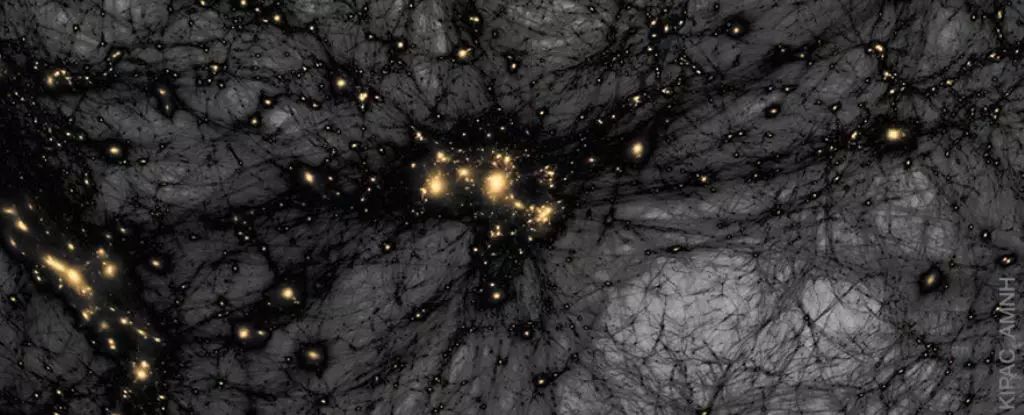In the vast expanse of the universe, where galaxies collide and stars are born, a perplexing question looms large over cosmology: what lies at the heart of the so-called Hubble tension? Observations reveal a conflict between the rates of cosmic expansion derived from early universe data and those gathered from a more local vantage. This discrepancy has ignited intense debates and spurred myriad theories, from challenging the tenets of general relativity to reimagining the nature and existence of dark matter itself. It’s as if the fundamental fabric of reality is unraveling before our eyes, revealing threads that are perhaps more mutable than we ever considered.
Rethinking Dark Matter
Traditional perspectives on dark matter are often rigid, dominated by the archetype of a static entity that passively influences cosmic structure. However, a burgeoning concept dares to challenge this orthodoxy: the notion that dark matter may not be fixed in its properties. While dark energy has received extensive scrutiny regarding its potential to evolve over time, dark matter has remained anchored to a more conventional identity. If the nature of dark matter can indeed be fluid, it opens new pathways for investigation and provides potential solutions for prevailing cosmic enigmas.
Recent work has introduced the fascinating hypothesis that dark matter could evolve, reshaping our understanding of its role in the cosmos. The study proposes a scenario where dark matter is not just a passive component in the universe’s architecture but an active player that changes its characteristics over time. This evolution could manifest as a dynamic equation of state that oscillates, thereby allowing for a richer interaction with the surrounding universe.
The Proxy of Exotic Dark Matter
What’s particularly captivating about the idea of evolving dark matter is its potential link to exotic forms of matter. The researchers suggest a model wherein a small fraction—around 15%—of dark matter exhibits oscillatory behavior, while the rest remains “standard” cold dark matter. This dual approach not only aligns with existing observational evidence but also provides an elegant framework to reconcile the apparent discrepancies posed by Hubble tension.
The inspiration drawn from neutrinos—particles that exhibit mass oscillation and are known to be a form of hot dark matter—offers a tantalizing glimpse into the possibilities for cold dark matter. This could signify a paradigm shift in our understanding, moving towards a universe that is not only expanding but is also alive and changing in its composition.
Observational Data: A New Lens
While it is crucial to acknowledge that this evolving dark matter model is still largely theoretical, the dialogue it encourages is invaluable. The foundation of any scientific theory lies in its ability to withstand the crucible of observation and experimentation. By suggesting an adaptable nature for dark matter, researchers are not merely conjecturing—they are re-approaching the available data with fresh eyes. By harmonizing evolving dark matter with current observations, we could gain a more nuanced understanding of the universe’s composition and dynamics.
Moreover, the interplay between evolving dark matter and dark energy cannot be overstated. As the researchers note, the evolution of these components may mirror one another, blurring the lines that regulate their individual behaviors. This interconnectedness is not merely a technical detail but a philosophical shift in how we perceive the interplay of forces that govern our cosmos.
The Path Forward: What Lies Ahead?
With the door opened to these novel interpretations, the scientific community is ripe for exploration. Evolving dark matter encourages a more flexible model of the universe—one that embraces the complexities and paradoxes inherent in cosmic phenomena. Like a painter wielding a brush effortlessly across a canvas, this idea allows us to add vibrant strokes to our depiction of the universe.
As we probe deeper into the nature of dark matter, we might just discover an array of previously unimagined structures and interactions. This phenomenon calls for a transformation in research methodologies, emphasizing innovative approaches that can probe both the cosmos and the underlying properties of dark matter. In a community often locked in the dichotomies of confirmatory biases, the evolving dark matter hypothesis serves as a compelling reminder that mystery and discovery are at the essence of scientific inquiry.
As the universe continues its grand dance of expansion, the evolving nature of dark matter may hold the key to understanding not just the cosmos, but the very foundations of our understanding of reality itself.


Leave a Reply